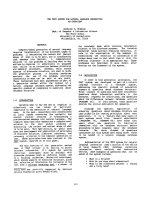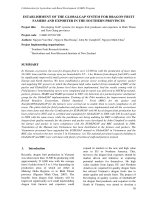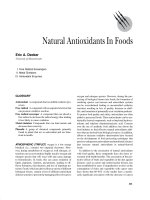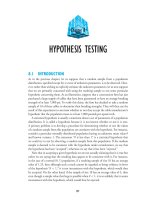Ebook The Bethesda system for reporting cervical cytology (3rd edition): Part 2
Bạn đang xem bản rút gọn của tài liệu. Xem và tải ngay bản đầy đủ của tài liệu tại đây (21.49 MB, 184 trang )
5
Epithelial Cell Abnormalities: Squamous
Michael R. Henry, Donna K. Russell, Ronald D. Luff,
Marianne U. Prey, Thomas C. Wright Jr, and Ritu Nayar
5.1
Epithelial Cell Abnormalities
Squamous Cell
• Squamous Intraepithelial Lesion (SIL)
– Low-grade squamous intraepithelial lesion (LSIL)
– High-grade squamous intraepithelial lesion (HSIL)
• With features suspicious for invasion (if invasion is suspected)
• Squamous cell carcinoma
M.R. Henry, MD (*)
Department of Laboratory Medicine, Mayo Clinic, 200 1st Street SW, Rochester,
MN 55905, USA
e-mail:
D.K. Russell, CT(ASCP)HT, MEd
Department of Pathology and Laboratory Medicine, University of Rochester Medical Center,
601 Elmwood Avenue, 626, Rochester, NY 14642, USA
e-mail:
R.D. Luff, MD, MPH
Anatomic Pathology Division for Clinical Trials, Quest Diagnostics, Teterboro, NJ 07608, USA
e-mail:
M.U. Prey, MD
8829 Ladue Road, Ladue, Missouri 63124, USA
e-mail:
T.C. Wright Jr, MD
Department of Pathology and Cell Biology, Columbia University,
631 W 168th St, New York, NY 10032, USA
e-mail:
R. Nayar, MD
Department of Pathology, Feinberg School of Medicine, Northwestern University, Northwestern
Memorial Hospital, 251 East Huron Street, Galter Pavilion, 7-132B, Chicago, IL 60611, USA
e-mail:
© Springer International Publishing Switzerland 2015
R. Nayar, D.C. Wilbur (eds.), The Bethesda System for Reporting Cervical
Cytology: Definitions, Criteria, and Explanatory Notes,
DOI 10.1007/978-3-319-11074-5_5
135
136
5.2
M.R. Henry et al.
Background
Squamous abnormalities encompass the spectrum of noninvasive cervical epithelial
abnormalities associated with human papillomavirus (HPV), ranging from the cellular changes that are associated with transient HPV infection to those representing
high-grade precursors, to invasive squamous cell carcinoma. It has now been well
established that HPV is the main causal factor in the pathogenesis of virtually all cervical cancer precursors and invasive cancers [1]. The majority of invasive cervical
cancers and their precursors contain HPV types referred to as “high-risk” HPVs
(hrHPV), the most common being HPV 16 [2]. Our understanding of preinvasive
HPV-associated squamous lesions supports only two conceptual divisions: HPV
infection and true precancer. Transient infections generally regress over the course of
1–2 years [3, 4], and lesions with HPV persistence are associated with an increased
risk of developing a cancer precursor (precancer) or invasive cancer [5–7]. This concept led to the introduction of the two-tiered nomenclature of low-grade squamous
intraepithelial lesion (LSIL) and high-grade squamous intraepithelial lesion (HSIL),
by the Bethesda System (TBS) in 1988.
In 2012, the Lower Anogenital Squamous Terminology Standardization
Consensus Conference (LAST) adopted a two-tiered nomenclature, mirroring the
Bethesda SIL classification, for the histologic diagnoses of HPV-associated squamous lesions of the lower anogenital tract [8]. Similarly, the 2014 WHO histopathology terminology for squamous cell precursors also advocated the use of a
two-tiered classification system [9]. The basis of these recommendations was the
fact that HPV-related lesions of the lower anogenital, both mucosal and cutaneous,
have similar biology and accompanying risks for development of invasive carcinoma and should be managed similarly. In TBS for cytology and LAST/WHO for
histopathology, LSIL encompasses the cellular changes associated with the older
terms of koilocytosis, mild dysplasia, and CIN 1, while HSIL encompasses the
more clinically significant lesions previously termed moderate and severe dysplasia,
CIN 2, CIN 3, and carcinoma in situ.
At the 1988 Bethesda workshop, when the spectrum of SIL was subdivided into
two categories, there were two main considerations. First was the desire to use morphologic categories that relate to the biology and clinical management of HPVassociated lesions as outlined above, and second was the acknowledged low inter- and
intraobserver reproducibility with three- and four-grade classification systems
[10, 11]. Then and since, it has been argued that a two-tiered system provides less
information to clinicians than a three-tiered CIN terminology [12]. However, the cytologic distinction of CIN 2 and CIN 3 is poorly reproducible, and combining the cytologic correlates of biopsy-confirmed CIN 2 and CIN 3 into a single HSIL category
was shown, in the ASCUS-LSIL Triage Study (ALTS), to have improved reproducibility (M. Schiffman, personal communication). Another concern voiced about the
two-tiered classification is that the dividing line between low-grade and high-grade
precursors should be set between CIN 2 and CIN 3 because the natural history of
untreated CIN 2 is closer to that of CIN 1 than it is to CIN 3 [13]. In some European
countries, CIN 1 and CIN 2 are grouped together for treatment purposes [12].
5
Epithelial Cell Abnormalities: Squamous
137
However, as a screening test, cervical cytology must emphasize sensitivity. Given the
variability in the interpretation and biologic behavior of “cytologic CIN 2” [14], setting the cytologic threshold for low-grade and high-grade lesions between CIN 1 and
CIN 2 is still considered appropriate. This cut point also demonstrated the best
interobserver reproducibility using a dichotomous positive/negative result, based on
data from ALTS (M. Schiffman, personal communication).
Even with only two categories of SIL, there is an overall 10–15 % inter-pathologist
discrepancy rate between LSIL and HSIL interpretations on cervical cytology slides
[15]. Cytology may also be discrepant with histology; 15–25 % of women with LSIL
cytology are found to have histologic HSIL (CIN 2/CIN 3) upon further evaluation
[16]. Benchmark data obtained from the College of American Pathologists (CAP)
show that in 2006 the median rate for LSIL was 2.5 % for all preparation types and
2.9 % for liquid-based preparations. The median rate for HSIL was 0.5 % for all
preparations types [17]. As of 2013, these rates have shown only minimal change.
The Bethesda System for reporting cervical cytology has been widely implemented, and current consensus management guidelines in the United States utilize
the two-tiered LSIL/HSIL nomenclature to make clinical decisions regarding follow-up of abnormal cervical cytology test results [18]. There has been a shift in
recent years with regard to the management of low-grade lesions especially in
young women based on the recognition that most LSIL (CIN 1) represent a selflimited HPV infection [19]. The current emphasis of cervical cancer screening is
therefore focused on detection and treatment of biopsy-confirmed high-grade
disease [18].
Thus, the 2014 Bethesda update maintains the two-tiered reporting terminology
of LSIL/HSIL.
5.3
Low-Grade Squamous Intraepithelial Lesion (LSIL)
(Figs. 5.1–5.13)
Squamous cell changes associated with HPV infection encompass “mild dysplasia”
and “CIN 1.” Several studies have demonstrated that the morphologic criteria for
distinguishing “koilocytosis” from mild dysplasia or CIN I vary among investigators and lack clinical significance. In addition, both lesions share similar HPV types,
and their biologic behavior and clinical management are similar, thus supporting a
common designation of LSIL [20–22].
5.3.1
Criteria
Cells occur singly, in clusters, and in sheets.
Cytologic changes are usually confined to squamous cells with “mature” intermediate or superficial squamous cell-type cytoplasm.
Overall cell size is large, with fairly abundant “mature” well-defined cytoplasm.
Nuclear enlargement more than three times the area of normal intermediate nuclei
results in a low but slightly increased nuclear to cytoplasmic ratio (Fig. 5.1).
138
M.R. Henry et al.
Fig. 5.1 Nuclear area (LBP, ThinPrep). The nuclear area of an intermediate squamous cell is
approximately 35 μm2. This is used as a reference to measure abnormal squamous cells such as
ASC-US (approximately 100 μm2) and LSIL (approximately 150–175 μm2)
Nuclei are generally hyperchromatic but may be normochromatic.
Nuclei show variable size (anisonucleosis).
Chromatin is uniformly distributed and ranges from coarsely granular to smudgy or
densely opaque (Fig. 5.2).
Contour of nuclear membranes is variable ranging from smooth to very irregular
with notches (Fig. 5.2).
Binucleation and multinucleation are common (Fig. 5.3).
Nucleoli are generally absent or inconspicuous if present.
Koilocytosis or perinuclear cavitation consisting of a broad, sharply delineated clear
perinuclear zone and a peripheral rim of densely stained cytoplasm is a characteristic viral cytopathic feature but is not required for the interpretation of LSIL
(Figs. 5.4 and 5.6).
Cells may show increased keratinization with dense, eosinophilic cytoplasm with
little or no evidence of koilocytosis.
Cells with koilocytosis or dense orangeophilia must also show nuclear abnormalities to be diagnostic of LSIL (Figs. 5.4–5.6); perinuclear halos or clearing in the
absence of nuclear abnormalities does not qualify for the interpretation of LSIL
(Fig. 5.7; see Fig. 2.36).
5
Epithelial Cell Abnormalities: Squamous
a
139
b
Fig. 5.2 Low-grade squamous intraepithelial lesion (LSIL) (a, left: LBP, ThinPrep and b, right
cervix, H&E stain). Nuclear enlargement and hyperchromasia are of sufficient degree for the interpretation of LSIL (a & b). HPV-associated cytoplasmic changes are not a prerequisite for LSIL
Fig. 5.3 LSIL (LBP, ThinPrep). A 32-year-old woman, day 15, routine cervical cytology screening. Note the overall large cell size, “smudged” nuclear chromatin, well-defined cytoplasm, and
multinucleation
140
M.R. Henry et al.
Fig. 5.4 LSIL (LBP, ThinPrep). Routine screen from a 32-year-old woman. Nuclear abnormalities
are required to make an interpretation of LSIL. HPV cytopathic effect manifested by perinuclear
cavitation often accompanies the nuclear abnormalities but is not required for an interpretation of
LSIL
Fig. 5.5 LSIL (LBP, SurePath). Cells with diagnostic koilocytic features of LSIL have a sharply
defined perinuclear cavity, condensation of cytoplasm around the periphery, and abnormal nuclear
features including enlargement and nuclear membrane irregularity. In liquid-based samples,
nuclear hyperchromasia may be less evident
5
Epithelial Cell Abnormalities: Squamous
141
Fig. 5.6 LSIL (LBP, ThinPrep). A 28-year-old woman with a history of ASC-US and positive
hrHPV testing. LSIL on cytology is characterized by mature squamous cells with enlarged nuclei
with variable chromatin and nuclear membranes. Koilocytosis or perinuclear cavitation in the cytoplasm, a characteristic of HPV cytopathic effect is present, however it is not required for an interpretation of LSIL
a
b
Fig. 5.7 Pseudokoilocytes (LBP, ThinPrep). Glycogen in squamous cells can give the appearance
of “pseudokoilocytosis” (a). The halos associated with glycogen often have a yellow refractile
appearance (b). The nuclear abnormalities required for an interpretation of LSIL are absent.
Follow-up in both cases was NILM
142
M.R. Henry et al.
Preparation-Specific Criteria
In LSIL, there are minimal differences between conventional preparations and
liquid-based preparations.
The nuclei may show less hyperchromasia on LBPs, but overall the morphology of
the cells is the same as in conventional preparations.
5.4
Problematic Patterns in LSIL
An interpretation of LSIL should be based on strict criteria to avoid unnecessary
follow-up of women for nonspecific morphologic changes. By and large, the
interobserver reproducibility of LSIL on cytology is far greater than LSIL (CIN 1)
on histology [23]. A few pitfalls and gray areas should be kept in mind.
5.4.1
Keratinized Squamous Cells (Fig. 5.8)
Parakeratosis, as represented by miniature squamous cells with round to oval
small, pyknotic nuclei and low nuclear to cytoplasmic ratios, is by itself not an
a
b
Fig. 5.8 ASC-US versus LSIL (a left CP, b Right LBP, ThinPrep). Atypical squamous cells with
orangeophilic cytoplasm (“atypical parakeratosis”). These cells have some features of SIL; however,
such keratinized lesions may be difficult to grade. hrHPV triage is helpful in determining follow-up
5
Epithelial Cell Abnormalities: Squamous
143
HPV-related entity (see Chap. 2). However, parakeratosis may be found as a
background pattern in HPV-associated lesions and as such should elicit a careful
search for classic HPV-related cytologic changes (see Figs. 2.15 and 2.16).
Keratinized cells showing nuclear abnormalities and low N/C ratios should be
categorized as “atypical squamous cells–undetermined significance” (ASC-US)
(see Figs. 4.15 and 4.16) or higher, based on the degree of nuclear abnormality
(Figs. 5.8 and 5.9).
5.4.2
Borderline Changes (Figs. 5.9–5.11)
Specimens with borderline nuclear changes that fall short of a definitive LSIL interpretation may be categorized as “atypical squamous cells–undetermined significance” (ASC-US) (Figs. 5.9–5.11).
Fig. 5.9 ASC-US versus LSIL (LBP, ThinPrep). A 32-year-old woman. Clusters of squamous cells
may be seen in “spikelike” aggregates; such clusters should be classified based on the degree of nuclear
abnormalities. This patient had an LSIL interpretation on a conventional smear 2 months before this
cytology which was interpreted as ASC-US. hrHPV test was positive
144
M.R. Henry et al.
Fig. 5.10 ASC-US versus LSIL (CP). Nuclear features are borderline between those required for
ASC-US and LSIL. Cases such as this will no doubt have poor interobserver reproducibility as
demonstrated in various studies including the Bethesda 2001 BIRST project
Fig. 5.11 ASC-US versus LSIL (LBP, ThinPrep). Abnormal nuclear enlargement without
concomitant HPV cytopathic change is identified in this Pap test from a 32-year-old woman. The
hallmark of LSIL is an enlarged nucleus, often as much as four to six times the area of a normal
intermediate cell nucleus. The N/C ratio is low and hyperchromasia varies, especially in liquidbased preparations
5
Epithelial Cell Abnormalities: Squamous
145
5.5
Mimics of LSIL
5.5.1
Pseudokoilocytosis (Fig. 5.7)
Cytoplasmic perinuclear clearing without accompanying atypical nuclear features
should not be considered as LSIL (Fig. 5.7a). Small indistinct perinuclear halos are
often seen in Trichomonas infections or in other reactive processes (see Figs. 2.36
and 2.52). Cytoplasmic vacuolization due to glycogen often takes on a yellow
refractile, “cracked” appearance (Fig. 5.7b).
5.5.2
Herpes Cytopathic Effect (Fig. 5.12)
Classical herpes cytopathic effect, with multinucleated cells showing nuclear molding, margination of chromatin, and clear, ground glass nuclei, does not typically
pose a differential diagnostic problem in comparison to LSIL. However, early herpes cytopathic effect may lack diagnostic nuclear features. Given the nuclear
enlargement and degenerative chromatin, which may be hyperchromatic, such cases
may be mistaken for LSIL (Fig. 5.12b). These cells lack the other changes of HPV
cytopathic effect such as koilocytosis, and often other cells in the preparation will
show more classic diagnostic changes of herpes. Occasionally, herpetic changes
may also mimic HSIL (Fig. 5.12a).
a
b
Fig. 5.12 Herpes (LBP, ThinPrep). Routine cervical cytology. A 25-year-old woman. Endocervical
cell (a) and intermediate cells (b) showing herpes virus cytopathic effect with clearing of chromatin. These cells can be mistaken for ASC-US or LSIL (b) or occasionally HSIL (a) when obvious
nuclear changes associated with herpes virus infection are not seen. Looking elsewhere on the
same slide will usually clarify that the changes are due to herpes cytopathic effect
146
M.R. Henry et al.
a
b
Fig. 5.13 Radiation change versus squamous cell carcinoma (CP). (a) A 61-year-old woman with
a history of squamous cell carcinoma and radiation. Mature squamous cell showing cytomegaly,
low N/C ratios, intracytoplasmic vacuoles with neutrophils. The mild enlargement of the nucleus
should not be mistaken for LSIL. (b) Patients radiated for squamous cell carcinoma may also show
tumor cells with radiation effect. These changes should be distinguished from radiation changes in
benign cells (a)
5.5.3
Radiation Changes (Fig. 5.13)
Cells showing the effects of ionizing radiation have a low nuclear to cytoplasmic
ratio with large nuclei which are often the same size as those seen in LSIL. The
cytoplasm of these cells is usually quite distinctive with a two-toned, vacuolated
appearance that lacks the perinuclear clearing and peripheral condensation present in a typical koilocyte (Fig. 5.13a; see Fig. 2.43). Patients radiated for squamous cell carcinoma may also show tumor cells with radiation effect (Fig. 5.13b),
and these changes should be distinguished from radiation changes in benign
cells.
5.6
Management of LSIL
In the data from the ASCUS-LSIL Triage Study (ALTS), hrHPV types were detected
in 85 % of LSIL cases, with the conclusion being that HPV testing is not a useful
triage strategy for cytologic LSIL, particularly in young women because of the high
5
Epithelial Cell Abnormalities: Squamous
147
prevalence of HPV infection in this age group [24]. On the contrary, reflex HPV
testing is acceptable for LSIL in postmenopausal women due to higher specificity in
this population.
With the advent of HPV co-testing in women over the age of 30, many women
with an interpretation of LSIL will have concurrent HPV testing. Thus, the 2012
ASCCP management guidelines recommend that women under the age of 25 with
a cytologic interpretation of LSIL be followed up with cytology at 12 months.
Women 25 years and older can be cotested in 3 years if they are HPV negative, but
colposcopic examination is recommended if HPV positive. Women of unknown
HPV status should have a repeat cytology in 12 months [18].
5.7
High-Grade Squamous Intraepithelial Lesion (HSIL)
(Figs. 5.14–5.48)
5.7.1
Criteria
The cells of HSIL are smaller and show less cytoplasmic maturity than cells of LSIL
(Fig. 5.14).
Cells occur singly, in sheets, or in syncytial-like aggregates (Figs. 5.15 and 5.16).
Syncytial aggregates of dysplastic cells may result in hyperchromatic crowded
groups. (HCG) of immature cells which should always be carefully assessed for
nuclear abnormalities (Fig. 5.15, 5.16, and 5.17).
While overall cell size is variable, in general, the cells of HSIL are smaller than
those of LSIL. Higher-grade lesions often contain quite small basal-type cells
(Figs. 5.28, 5.40, and 5.45).
Degree of nuclear enlargement is more variable than that seen in LSIL. Some
HSIL cells have the same degree of nuclear enlargement as in LSIL, but
the cytoplasmic area is decreased, leading to a marked increase in the nuclear
to cytoplasmic ratio (Figs. 5.18 and 5.19). Other cells have very high nuclear/
cytoplasmic ratios, but the actual size of the nuclei may be considerably smaller
than that of LSIL, at times even as small as a normal intermediate cell nucleus
(Fig. 5.21).
Nuclear to cytoplasmic ratio is higher in HSIL compared to LSIL.
Nuclei are generally hyperchromatic but may be normochromatic or even hypochromatic (Fig. 5.22).
Chromatin may be fine or coarsely granular and is evenly distributed.
Contour of the nuclear membrane is quite irregular and frequently demonstrates
prominent indentations (Figs. 5.20 and 5.23) or grooves (Fig. 5.24).
Nucleoli are generally absent, but may occasionally be seen, particularly when
HSIL extends into endocervical gland spaces or in the background of reactive or
reparative change (Fig. 5.25).
Appearance of the cytoplasm is variable; it can appear “immature,” lacy, and delicate (Fig. 5.19) or densely metaplastic (Fig. 5.20); occasionally, the cytoplasm is
“mature” and densely keratinized (keratinizing HSIL) (Figs. 5.26 and 5.43).
148
M.R. Henry et al.
Fig. 5.14 High-grade squamous intraepithelial lesion (HSIL) (LBP, ThinPrep). There is a mixture
of dysplastic cells here, one large LSIL cell, and four adjacent, small, high N/C ratio cells with
nuclear features consistent with HSIL
Fig. 5.15 High-grade squamous intraepithelial lesion (HSIL) (CP). The dysplastic cells are seen
here in a syncytial cluster or hyperchromatic crowded group
5
Epithelial Cell Abnormalities: Squamous
149
Fig. 5.16 HSIL-syncytial cluster (LBP, SurePath). As in conventional smears, crowded hyperchromatic cell groups should be examined with care. If a squamous abnormality is suspected, a
thorough search for single dysplastic cells in the background is warranted. Follow-up showed
HSIL (CIN 3) with endocervical gland involvement
Fig. 5.17 HSIL (CP). A 58-year-old postmenopausal woman on hormone replacement therapy.
Hyperchromatic crowded groups seen at low power require careful examination at higher magnification. Flattening at the edge of the cell cluster and whorling in the center are suggestive of HSIL over
a glandular abnormality. Follow-up showed HSIL (CIN 3) with endocervical gland involvement
150
M.R. Henry et al.
Fig. 5.18 HSIL (CP). Nuclear changes are HSIL; however, the nuclear/cytoplasmic (N/C) ratio is
on the low end for HSIL
Fig. 5.19 HSIL (CP). There is variation in nuclear size and shape, and the cells have delicate
cytoplasm
5
Epithelial Cell Abnormalities: Squamous
151
Fig. 5.20 HSIL (CP). HSIL with “metaplastic” or dense cytoplasm, in contrast to that seen in the
syncytial groups of HSIL (Fig. 5.19)
Fig. 5.21 HSIL (CP). HSIL cells with some variation in cell size and N/C ratios. A cluster such
as this may be misinterpreted as squamous metaplastic cells if examined only under lower magnification. Follow-up showed HSIL (CIN 3)
152
M.R. Henry et al.
a
b
Fig. 5.22 HSIL (a, b LBP, ThinPrep). HSIL that is markedly hypochromatic. A diligent search
may reveal more classic cells elsewhere on the same slide. (a) On the left side, note syncytial
arrangement and nuclear grooves. (b) On the right side, abnormal naked nuclei and a hyperchromatic, high N/C ratio single HSIL cell are seen
a
b
Fig. 5.23 HSIL (a, b LBP, SurePath). Note the nuclear envelope irregularities and abnormal chromatin. As seen here in LBPs, hyperchromasia may not be as prominent as in conventional smears
5
Epithelial Cell Abnormalities: Squamous
153
Fig. 5.24 HSIL (LBP, ThinPrep). Cells showing variably sized, ovoid nuclei with prominent
nuclear grooves. In this case, the chromatin is not particularly hyperchromatic, and cytoplasm has
ill-defined borders
Fig. 5.25 HSIL (CP). A 42-year-old woman. Although uncommon, nucleoli may be seen in
HSIL, especially with extension into endocervical gland spaces. The chromatin may appear less
coarsely granular
154
M.R. Henry et al.
Fig. 5.26 HSIL-keratinizing lesion (CP). The criteria of nuclear to cytoplasmic ratio and degree
of nuclear abnormalities used for grading SIL may be more difficult to apply to keratinizing
lesions. The extent of abnormality here qualifies for an interpretation of HSIL (contrast with
Figs. 5.8 and 5.9)
a
b
Fig. 5.27 HSIL (a, b: LBP, ThinPrep). A 29-year-old woman from a high-risk clinic. Close attention
to isolated cells is required when screening LBPs because the abnormal isolated cells may not be as
apparent as clusters of HSIL cells and may lie between benign cell clusters or in “empty spaces” on
the preparation. When the criteria for HSIL are met, such cells should be interpreted as HSIL and not
ASC-H. Both images (a and b) demonstrate such cells. Follow-up showed HSIL (CIN 3)
5
Epithelial Cell Abnormalities: Squamous
155
Preparation-Specific Criteria
Liquid-Based Preparations:
Dispersed abnormal single cells are seen more often than sheets and syncytial
aggregates, and isolated cells may be present in the empty spaces between cell
clusters (Figs. 5.27 and 5.28).
Relatively fewer abnormal cells may be present.
Cells may be quite small and can be mistaken for histiocytes or endometrial cells.
Nuclei may be normochromatic or even hypochromatic, but other cytologic features
of HSIL (high nuclear to cytoplasmic ratio and irregular nuclear membrane) are
present [25] (Figs. 5.22 and 5.23).
Fig. 5.28 HSIL (LBP, ThinPrep). Isolated single abnormal cells (arrow) are more often seen in LBPs.
These small cells may be seen in the spaces between cells as seen here and may be easily missed on
screening. The inset magnifies the cell indicated by the arrow, which shows abnormal features including a large hyperchromatic nucleus with irregular nuclear membranes and increased N/C ratio
156
M.R. Henry et al.
5.8
Problematic Patterns in HSIL
5.8.1
Syncytial Aggregates/Hyperchromatic Crowded Groups
(Figs 5.15–5.17 and 5.29)
Cellular aggregates of high-grade squamous lesions in conventional smears
often have a syncytial-like appearance with no visually discernable cytoplasmic
borders between the cells and loss of nuclear polarity within the groups.
Specimens collected using modern sampling devices and prepared using liquidbased methodologies often demonstrate tight clusters which appear to be hyperchromatic due to a three-dimensional arrangement of cells showing scant
cytoplasm and variable chromasia of the nuclei. These clusters should be closely
examined for the presence of abnormal features which justify an interpretation
of HSIL [26].
The cytomorphologic features of HSIL include significant anisonucleosis,
coarsely granular chromatin, irregular nuclear membranes, and increased nuclear
to cytoplasmic ratios. The presence of mitoses within these clusters is also suggestive of an epithelial abnormality. While the center of such clusters is often
difficult to evaluate due to the dense and dark nature of these groups, close examination of the periphery of the cluster will usually allow for better evaluation of the
cells.
The differential diagnosis for syncytial groups includes a variety of benign entities such as immature squamous metaplasia, atrophy, and benign endocervical or
endometrial cells. If the cells are abnormal squamous cells, but not diagnostic of
HSIL, the appropriate interpretation would be ASC-H. If the cells are abnormal but
with glandular features, the differential considerations would include endocervical
adenocarcinoma in situ or endocervical or endometrial adenocarcinoma. Flattening
at the edges of the cell cluster, whorling of cells in the center, and lack of glandular
architectural features (feathering, rosettes, and pseudostratified strips) favor HSIL
over a glandular abnormality (see Table 6.1 for differential diagnosis of HSIL and
AIS) (Figs. 5.15–5.17, 5.29–5.30).
5
Epithelial Cell Abnormalities: Squamous
157
Fig. 5.29 HSIL (LBP, ThinPrep). A 32-year-old woman with a history of abnormal Pap tests and
positive hrHPV testing. A syncytial cluster of cells with overlapping of hypochromatic nuclei are
seen. The nuclei are often less hyperchromatic in liquid-based preparations. Follow-up cone
biopsy revealed HSIL (CIN 3)
Fig. 5.30 HSIL (CIN 3) (cervix, H&E stain). The histology of HSIL (CIN 3) reflects the findings
seen in clusters of HSIL seen on cytology. The abnormal immature cells show minimal maturation
from the base of the epithelium to the surface with nuclear size and shape variation
158
5.8.2
M.R. Henry et al.
SIL with Endocervical Gland Involvement (Figs. 5.31–5.34)
When SIL, especially HSIL, extends into the endocervical glands, resultant cell
clusters may be misinterpreted as being of glandular origin. Clues that the lesion is
actually of squamous origin include centrally located cells showing spindling or
Fig. 5.31 HSIL with extension into endocervical gland space (LBP, SurePath). Note flattening of
cells at the edge of the cluster, a feature that favors HSIL over a glandular lesion
Fig. 5.32 HSIL (CIN 3) with extension into endocervical glands (cervix, H&E stain). Squamous
dysplasia, especially high-grade lesions, often extends into endocervical glands replacing the normal endocervical glandular cells
5
Epithelial Cell Abnormalities: Squamous
159
whorling with flattening of the nuclei at the periphery of the cluster, giving a smooth,
rounded border (Figs. 5.17, 5.31–5.34). However, in distinction from the syncytial
groups of HSIL mentioned above, HSIL in endocervical glands may demonstrate
peripheral palisading of cells and nuclear pseudostratification, features that are usually associated with glandular cervical lesions [25, 27].
On LBPs, loss of central cell polarity and piling within cell groups is observed
in HSIL involving glands but not in AIS. Also, in contrast to conventional smears,
nucleoli may be visualized in HSIL within glands on liquid-based preparations,
but are not as prominent as in AIS (Fig. 5.17) [28]. However, it must always be
remembered that HSIL and AIS can coexist in a single specimen [29] (see Figs.
6.33 and 6.34).
Fig. 5.33 HSIL (CP). A 30-year-old woman with atypical glandular cells on a prior Pap test. When
HSIL lesions involve endocervical glands, they may show features that overlap with those of adenocarcinoma in situ (AIS). Note normal columnar cells with residual mucin at the right upper edge of
the cell cluster (arrow). Follow-up showed CIN with endocervical gland involvement









